
Mimosa tenuiflora, syn. Mimosa hostilis, also known as jurema preta, calumbi (Brazil), tepezcohuite (México), carbonal, cabrera, jurema, black jurema, and binho de jurema, is a perennial tree or shrub native to the northeastern region of Brazil and found as far north as southern Mexico, and the following countries: El Salvador, Honduras, Panama, Colombia and Venezuela. It is most often found in lower altitudes, but it can be found as high as 1,000 m (3,300 ft).

Yuremamine is a phytoindole alkaloid which was isolated from the bark of Mimosa tenuiflora in 2005, and erroneously assigned a pyrrolo[1,2-a]indole structure that was thought to represent a new class of indole alkaloids. However, in 2015, the bioinspired total synthesis of yuremamine revealed its structure to be a flavonoid derivative. It was also noted in the original isolation of yuremamine that the alkaloid occurs naturally as a purple solid, but total synthesis revealed that yuremamine as a free base is colorless, and the formation of a trifluoroacetate salt during HPLC purification is what led to the purple appearance.
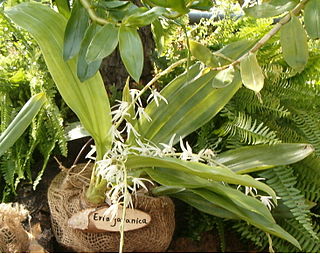
Eria is a genus of orchids with more than 50 species distributed in China, the Himalayas, the Indian Subcontinent, Southeast Asia, New Guinea, Polynesia, Melanesia and Micronesia.

Pinalia, commonly known as gremlin orchids, is a genus of flowering plants in the family Orchidaceae. Orchids in this genus are large epiphytic or lithophytic plants with prominent pseudobulbs, each with up to three thin, flat leaves and cup-shaped, relatively short-lived flowers with scale-like brown hairs on the outside. There are about 120 species occurring from tropical to subtropical Asia to the south-west Pacific.

Pinalia bractescens is a species of orchid.

Pinalia elata is a species of orchid found in Peninsular Malaysia.
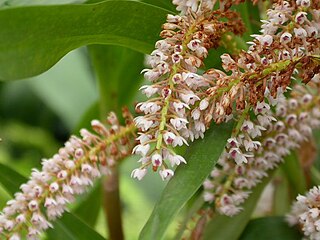
Pinalia multiflora is a species of orchid found in Java, the Lesser Sunda Islands and Sumatra.

Pinalia spicata is a species of orchid.

Galactia is a genus of flowering plants in the legume family (Fabaceae). It belongs to the subfamily Faboideae. They do not have an unambiguous common name, being commonly called milk peas, beach peas or wild peas.

Pinalia ovata is a species of orchid found from the Ryukyu Islands and Taiwan to the Philippines. It is an epiphyte that is found growing from 500 to 2,550 meters elevation. This species is erect and sympodial with pseudobulbs of 20 cm long by 1.2 cm diameter. It has about 4 leaves that are linear-oblong to oblong-lanceolate of 15 cm long and 2.1 cm wide.
Pinalia xanthocheila is a species in the plant family Orchidaceae.
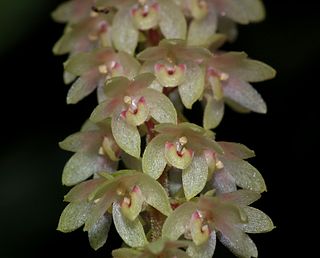
Pinalia polyura, or many-tailed pinalia, is a member of the orchid family endemic to the Philippines. It is semi-pendulous and sympodial, with pseudobulbs that are 20 cm long, 1 cm in diameter, and somewhat club shaped. Each new growth begins halfway along the previous year's pseudobulbs, making the plant longer each year. Each pseudobulb has about 5 shiny, lanceolate leaves approximately 15 cm long and 2 cm wide. Inflorescences appear at the upper portion of the plant and are pendulous, about 10 cm long and bear up to 40 flowers each 1.5 cm in diameter. It grows as an epiphyte and sometimes as a semi-terrestrial plant at elevations to 2,400 meters.
Daphne tenuiflora is a small shrub, of the family Thymelaeaceae. Daphne angustiloba is considered to be a synonym of D. tenuiflora, although the Flora of China treats it as a separate species. D. tenuiflora is native to China and Myanmar.
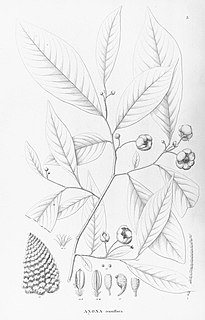
Annona tenuiflora is a species of plant in the family Annonaceae. It is native to Brazil, Colombia, French Guiana and Venezuela. Carl Friedrich Philipp von Martius, the German botanist who first formally described the species, named it after the slender sepals and petals of its flowers.
Pinalia acutifolia is a species of plant within the orchid family. It is native to the Indian subcontinent.
Pinalia affinis is a species of plant within the orchid family.
Pinalia chrysocardium is a species of orchid. It is native to Sumatra. It was reassigned from the genus Eria.
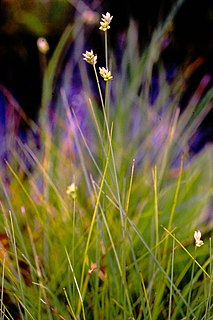
Carex tenuiflora, the sparse-flowered sedge, is a species of flowering plant in the family Cyperaceae. It is native to the Subarctic and Hemiboreal Northern Hemisphere; Alaska, Canada, the northern US, Scandinavia, the Baltic States, all of Russia, the north Caucasus, Siberia, the Russian Far East, Mongolia, northern China, Korea, and Japan. It is most often found in peatlands, preferring a pH of 6.
Streptoglossa tenuiflora is a species of flowering plant in the family Asteraceae. It is an upright perennial or annual herb with pink to purple flowers. It is endemic to Western Australia.












